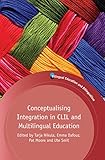Conceptualising Integration in CLIL and Multilingual Education / ed. by Tarja Nikula, Emma Dafouz, Pat Moore, Ute Smit.
Material type: TextSeries: Bilingual Education & BilingualismPublisher: Bristol ; Blue Ridge Summit : Multilingual Matters, [2016]Copyright date: ©2016Description: 1 online resourceContent type:
TextSeries: Bilingual Education & BilingualismPublisher: Bristol ; Blue Ridge Summit : Multilingual Matters, [2016]Copyright date: ©2016Description: 1 online resourceContent type: - 9781783096138
- 9781783096145
- 418.0071 23
- online - DeGruyter
- Issued also in print.
| Item type | Current library | Call number | URL | Status | Notes | Barcode | |
|---|---|---|---|---|---|---|---|
 eBook
eBook
|
Biblioteca "Angelicum" Pont. Univ. S.Tommaso d'Aquino Nuvola online | online - DeGruyter (Browse shelf(Opens below)) | Online access | Not for loan (Accesso limitato) | Accesso per gli utenti autorizzati / Access for authorized users | (dgr)9781783096145 |
Frontmatter -- Contents -- Contributors -- Acknowledgements -- Foreword: Integrating Content and Language in Education: Best of Both Worlds? -- More Than Content and Language: The Complexity of Integration in CLIL and Bilingual Education -- Part 1: Curriculum and Pedagogy Planning -- 1. Cognitive Discourse Functions: Specifying an Integrative Interdisciplinary Construct -- 2. Historical Literacy in CLIL: Telling the Past in a Second Language -- 3. Learning Mathematics Bilingually: An Integrated Language and Mathematics Model (ILMM) of Word Problem-Solving Processes in English as a Foreign Language -- 4. A Bakhtinian Perspective on Language and Content Integration: Encountering the Alien Word in Second Language Mathematics Classrooms -- Part 2: Participants -- 5. University Teachers' Beliefs of Language and Content Integration in English-Medium Education in Multilingual University Settings -- 6. CLIL Teachers' Beliefs about Integration and about Their Professional Roles: Perspectives from a European Context -- Part 3: Practices -- 7. Integration of Language and Content Through Languaging in CLIL Classroom Interaction: A Conversation Analysis Perspective -- 8. Teacher and Student Evaluative Language in CLIL Across Contexts: Integrating SFL and Pragmatic Approaches -- 9. Translanguaging in CLIL Classrooms -- Conclusion: Language Competence, Learning and Pedagogy in CLIL - Deepening and Broadening Integration -- References -- Index
restricted access online access with authorization star
http://purl.org/coar/access_right/c_16ec
Content and Language Integrated Learning (CLIL) is a form of education that combines language and content learning objectives, a shared concern with other models of bilingual education. While CLIL research has often addressed learning outcomes, this volume focuses on how integration can be conceptualised and investigated. Using different theoretical and methodological approaches, ranging from socioconstructivist learning theories to systemic functional linguistics, the book explores three intersecting perspectives on integration concerning curriculum and pedagogic planning, participant perceptions and classroom practices. The ensuing multidimensionality highlights that in the inherent connectedness of content and language, various institutional, pedagogical and personal aspects of integration also need to be considered.
Issued also in print.
Mode of access: Internet via World Wide Web.
In English.
Description based on online resource; title from PDF title page (publisher's Web site, viewed 24. Apr 2022)


